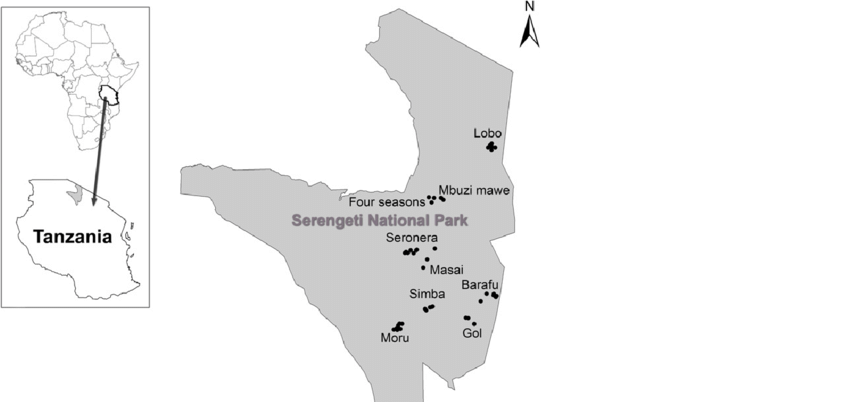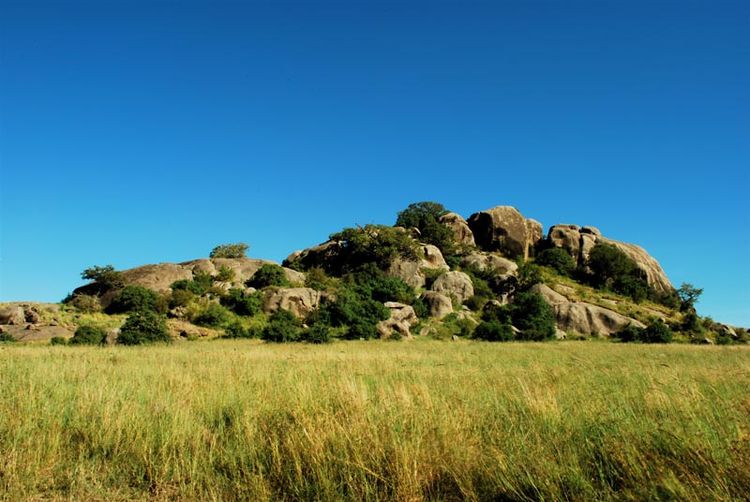Introduction to Kopjes
Kopjes (pronounced “ko-pees”) are ancient rock formations found in various ecosystems across Africa, with the Serengeti being home to some of the most iconic examples. These formations consist of large, weathered granite boulders that have stood for millions of years, shaping not only the landscape but also the ecology of the region. The term “kopje” is derived from the Dutch word for “little head” or “small hill,” which perfectly describes their protruding shapes in the otherwise flat savannah of the Serengeti.
Kopjes play a crucial role in Serengeti ecosystems, serving as islands of biodiversity within the grasslands. They provide shelter, hunting grounds, and breeding habitats for many animals. Their formation is a testament to Earth’s geological history, and their importance to both wildlife and ecological balance is immense.
How Kopjes Form
Kopjes are primarily formed through a process of geological erosion spanning millions of years. The following steps describe their formation:
- Precambrian Origin (Over 540 Million Years Ago):
- During the Precambrian era, intense volcanic activity forced magma (molten rock) from deep beneath the Earth’s surface upwards. This magma cooled slowly underground, forming massive granite rock intrusions known as batholiths. These intrusions remained beneath the Earth’s surface, surrounded by layers of softer sedimentary rock like sandstone and mudstone.
- Erosion of Overlying Sediments:
- Over time, the softer surrounding rocks began to erode due to natural processes like wind, rain, and temperature changes. The granite rock, being much harder, resisted this erosion while the softer rocks above and around it gradually wore away.
- Exposure of Granite:
- As the erosion continued over millions of years, the hard granite rocks that were once buried beneath layers of sediment were eventually exposed at the surface. This initial exposure marks the beginning of the kopje formation.
- Weathering and Shaping of the Granite:
- Even though granite is more resistant than other rocks, it too eventually erodes, though at a much slower pace. Over time, natural forces such as wind, water, and temperature fluctuations cause the granite to break along natural fractures, resulting in the rounded boulders and stacked formations we see today.
- Formation of Tors (Piled Rocks):
- Some kopjes exhibit distinctive tors, which are piles of granite boulders created as the granite splits along points of weakness. These tors are often seen as stacked rock formations, giving kopjes their unique visual appeal.
The kopjes of the Serengeti are some of the oldest geological formations in the world, dating back over 550 million years. The surrounding Serengeti rocks, some of which are over 1.2 billion years old, contribute to this ancient landscape.
Ecological Importance of Kopjes
Kopjes are often referred to as “islands” within the Serengeti, and for good reason. They provide a micro-ecosystem that supports life in the surrounding savannah and are essential for maintaining biodiversity. Their ecological significance includes:
- Shelter for Wildlife:
- The boulders and caves of kopjes provide shelter from the harsh sun and predators. Many species, including lions, leopards, and smaller animals like rock hyraxes, make their homes in and around kopjes. Predators often use these formations as lookouts to spot prey in the surrounding plains.
- Breeding Grounds:
- Many animals, especially birds and reptiles, use the isolated and safe spaces within kopjes to breed. Rock hyraxes, which are closely related to elephants, are commonly found in these rocky outcrops. Birds such as eagles and vultures use the elevated heights for nesting.
- Water Retention:
- In an otherwise dry landscape, kopjes often retain water in small pools that form in the cracks and crevices of the rock. These water sources are vital for animals during the dry season, attracting herbivores like elephants and giraffes, which in turn attract predators.
- Vegetation Diversity:
- The cracks and crevices of kopjes can support a variety of plant life, which would otherwise struggle to survive in the open plains. Unique plant species, including small trees and shrubs, thrive in the sheltered environment provided by the kopjes, creating pockets of biodiversity.
Famous Kopjes in the Serengeti
The Serengeti is home to 9 prominent kopje clusters, each with its own unique characteristics and wildlife populations. Here are the details;

1. Moru Kopjes
- Location: Southern Serengeti, near the southwest.
- Features: The Moru Kopjes are some of the most famous and impressive kopjes in the Serengeti, known for their large granite formations and iconic rock piles (tors). These kopjes are also culturally significant, containing Maasai rock paintings and ancient artifacts.
- Wildlife: Moru Kopjes are a known stronghold for black rhinos, and they provide habitats for a variety of predators like lions, as well as smaller creatures like hyraxes and reptiles.
2. Simba Kopjes
- Location: Central Serengeti, not far from the Seronera area.
- Features: The Simba Kopjes are named after the Swahili word for lion and are well-known for frequent lion sightings. The kopjes here are slightly smaller in size compared to Moru, but they provide crucial vantage points for predators.
- Wildlife: Lions are often seen here using the kopjes as lookout spots or shelter from the sun, especially during the dry season when prey is more concentrated.
3. Gol Kopjes
- Location: Southeastern Serengeti, closer to the Ndutu region.
- Features: The Gol Kopjes are found in a more remote part of the Serengeti and are characterized by their flat and open plains. This isolation makes them an important site for cheetah populations.
- Wildlife: Cheetahs are often seen in this region because the flat plains offer ideal hunting grounds. Wildebeest and zebra herds also pass through during migration.
4. Barafu Kopjes
- Location: East of Gol Kopjes, along the eastern boundary of the Serengeti.
- Features: The Barafu Kopjes are somewhat more scattered and less visited than other clusters. These formations provide shelter in an otherwise vast and open landscape.
- Wildlife: Barafu Kopjes offer shelter to a variety of wildlife, especially lions and other predators. During the migration, large herbivore herds also pass through.
5. Masai Kopjes
- Location: Central Serengeti, close to Seronera.
- Features: These kopjes are another popular tourist destination due to their close proximity to Seronera, the heart of Serengeti National Park. They offer a mix of scenic beauty and wildlife viewing opportunities.
- Wildlife: Lions, leopards, and hyenas are often seen around the Masai Kopjes, using them as shelter or resting spots. Birdlife, especially raptors, can also be observed here.
6. Seronera Kopjes
- Location: Central Serengeti, near the Seronera River.
- Features: These kopjes are a key feature of the central Serengeti ecosystem. They are often frequented by safari-goers due to their accessibility and the abundant wildlife in the surrounding areas.
- Wildlife: The Seronera area, including its kopjes, is known for year-round lion activity and frequent sightings of leopards and other predators. The proximity to water also makes it a critical habitat during the dry season.
7. Four Seasons Kopjes
- Location: North of Seronera, close to the luxury Four Seasons Safari Lodge.
- Features: These kopjes are located near a major safari lodge, offering unique wildlife viewing opportunities in a more private setting.
- Wildlife: As with the other kopjes, predators are often seen here, and the surrounding area supports a variety of wildlife, particularly during migration.
8. Mbuzi Mawe Kopjes
- Location: Northwestern Serengeti, between Seronera and Lobo.
- Features: The Mbuzi Mawe Kopjes are found in a less frequently visited area of the Serengeti. Their isolation provides a quieter and more remote experience for wildlife viewing.
- Wildlife: These kopjes serve as a refuge for wildlife during the dry season. Elephants, giraffes, and antelope species are commonly seen, along with predators like leopards.
9. Lobo Kopjes
- Location: Northeastern Serengeti, near the border with Kenya’s Masai Mara.
- Features: Lobo Kopjes are located in a more forested area of the Serengeti, offering a different habitat compared to the open plains of the south.
- Wildlife: Lobo Kopjes are a critical habitat for migratory species as they move between the Serengeti and Masai Mara. Lions and elephants are common, and the area is frequented by migrating wildebeest and zebras.
Threats to Kopjes and Conservation Efforts
Despite their resilience, kopjes and the ecosystems they support face various threats, including:
- Human Encroachment:
- Expansion of agricultural activities, livestock grazing, and human settlements in surrounding areas can disturb the natural environment around kopjes, leading to habitat loss and increased human-wildlife conflict.
- Climate Change:
- Changes in weather patterns can affect the availability of water in kopjes and alter the delicate balance of the ecosystems they support.
- Tourism Pressure:
- While tourism provides essential revenue for conservation, too many visitors in sensitive areas around kopjes can lead to habitat degradation and disturb wildlife.
To address these threats, ongoing conservation efforts include:
- Protected Area Status: Kopjes located within Serengeti National Park benefit from the protection of the park’s regulations, which limit human activities and promote sustainable tourism.
- Anti-Poaching Initiatives: Efforts to combat poaching have helped protect wildlife populations, especially vulnerable species like black rhinos, which rely on the safety provided by kopjes.
- Water Conservation: Protecting the water sources around kopjes is critical to ensuring the survival of the flora and fauna that depend on these rocky outcrops.
What animals depend on Serengeti kopjes?
Serengeti kopjes serve as critical habitats for a wide variety of animals. These rock formations provide shelter, breeding grounds, hunting perches, and water sources, making them essential to many species. Below are some key animals that depend on the Serengeti kopjes:
1. Lions
- Dependence on Kopjes: Lions are among the most iconic animals associated with Serengeti kopjes. They use these rock formations as vantage points to survey the surrounding savannah for prey. The shaded areas between the rocks also provide lions with a place to rest during the heat of the day.
- Notable Kopjes: The Simba Kopjes in central Serengeti are named after the Swahili word for lion, reflecting their frequent use by lion prides.
2. Leopards
- Dependence on Kopjes: Leopards, known for their elusive nature, often use kopjes as hiding spots to stash their kills away from scavengers like hyenas. They also take advantage of the rocks for resting and observing their territory.
- Behavior Around Kopjes: The rocky outcrops give leopards ample spaces to camouflage and hunt. Their agility allows them to move swiftly among the boulders, making kopjes ideal habitats for ambush hunting.
3. Cheetahs
- Dependence on Kopjes: Cheetahs, although typically associated with open plains, are also spotted near kopjes. They often climb the rocks to gain an elevated view of potential prey. The open terrain around the kopjes also allows cheetahs to exploit their incredible speed when hunting.
- Notable Kopjes: The Gol Kopjes in the southeastern Serengeti are prime cheetah habitats due to the flat surrounding plains, which provide the ideal hunting grounds for these predators.
4. Rock Hyraxes
- Dependence on Kopjes: Rock hyraxes are small, herbivorous mammals often found clambering on kopjes. They live in colonies and find refuge in the nooks and crannies of the rocky outcrops, which offer protection from predators like eagles and leopards.
- Behavior Around Kopjes: These animals are social and are often seen sunbathing on the rocks during the day, using the kopjes’ crevices for shelter at night.
5. Reptiles (Lizards and Snakes)
- Dependence on Kopjes: Various reptile species, including monitor lizards, agamas, and some snake species, depend on the kopjes for basking in the sun and finding prey. The rocks provide them with safe hiding places and temperature regulation, which is crucial for cold-blooded animals.
- Notable Species: Rock agamas, with their brightly colored males, are a common sight on kopjes, often seen basking on the sun-warmed rocks.
6. Birds of Prey
- Dependence on Kopjes: Birds of prey like eagles, vultures, and falcons use the high vantage points provided by kopjes to spot prey from afar. Kopjes also offer excellent nesting sites, protected from ground-based predators.
- Notable Behavior: Eagles and falcons use the rocky outcrops to nest, while vultures are often seen perched on kopjes, waiting for opportunities to scavenge.
7. Black Rhinos
- Dependence on Kopjes: Some of the Serengeti’s black rhino populations are known to inhabit areas around kopjes, especially in places like the Moru Kopjes. These rocky outcrops provide safety and shelter for these critically endangered animals.
- Behavior Around Kopjes: The thick vegetation surrounding kopjes can provide black rhinos with browsing opportunities, and the rocks themselves offer shade and protection from poachers.
8. Elephants
- Dependence on Kopjes: Elephants, while mainly using the plains for grazing, are often seen near kopjes where water pools may collect in the rocky crevices. The rocks also provide shade, and the vegetation around kopjes offers additional food sources.
- Notable Behavior: Elephants sometimes use kopjes to scratch their bodies against the rough surfaces, and they may rest in the cooler shaded areas around the rocks.
9. Giraffes
- Dependence on Kopjes: Giraffes, though typically associated with open woodland areas, are often spotted near kopjes where the vegetation may be denser due to water retention. The trees growing in and around kopjes provide an ideal food source for giraffes.
- Behavior Around Kopjes: Giraffes graze the tops of trees and shrubs that grow around kopjes, taking advantage of the rich vegetation that thrives in the microclimate around these rock formations.
10. Smaller Mammals (Mongooses and Baboons)
- Dependence on Kopjes: Kopjes are also home to various smaller mammals such as mongooses and baboons. Mongooses use the cracks and crevices of the kopjes for hiding and hunting, while baboons take advantage of the rocks as resting and foraging spots.
- Notable Behavior: Baboons, in particular, use kopjes as lookout points to spot predators and other threats.
11. Insects and Amphibians
- Dependence on Kopjes: Kopjes harbor a variety of insect species, many of which are drawn to the water that collects in the small pools formed on the rock surfaces. Additionally, some amphibians use these temporary water sources for breeding.
- Notable Species: Frogs and other amphibians are occasionally found in the rock pools during the rainy season.
Ecological Importance of Kopjes for Wildlife
Kopjes are more than just geological formations; they are essential ecological features that serve various functions in the Serengeti. Here’s a brief summary of their importance:
- Biodiversity Hotspots:
- The unique micro-habitats within kopjes support a wide range of plant and animal species that are not commonly found in the surrounding plains, increasing the overall biodiversity of the Serengeti ecosystem.
- Predator-Prey Interactions:
- Kopjes provide an advantageous landscape for predators like lions and leopards to hunt prey, and for prey animals to find temporary refuge from these predators.
- Refuge from Extreme Conditions:
- During the heat of the day or during rainstorms, kopjes provide vital shelter for a variety of species, helping animals cope with the harsh Serengeti climate.
- Water Retention:
- Kopjes retain water in their cracks and crevices, creating small oases for wildlife during the dry season. This feature is particularly important in an environment where water can be scarce.
In conclusion, kopjes are critical to the Serengeti’s wildlife. Their presence adds to the complexity and richness of the ecosystem, making them indispensable for the survival of many species. The Serengeti kopjes not only serve as key habitats but also contribute to the delicate ecological balance that defines this iconic landscape.
Conclusion
Kopjes are more than just scenic rock formations in the Serengeti; they are vital to the survival of numerous species and play an important role in the region’s biodiversity. Their unique geological history, combined with their role in the ecosystem, makes them one of the most fascinating features of the Serengeti landscape. Effective conservation and sustainable tourism practices are key to ensuring these ancient formations and the life they support continue to thrive for future generations.

